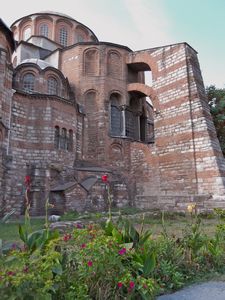Advertisement
Published: October 29th 2011

 Kariye Müsezi
Kariye Müsezi
The outside of the church isn't much to look at, but inside it is magnificent.Istanbul is home to endless historical monuments, tucked away in corners of the city. Some are thoroughly in the middle of the tourist trail, like the Aya Sofiya and Topkapı Palace. Others are known to tourist guides but not necessarily to all Istanbullus. Our taxi driver knew of Kariye but not really how to get there. Once we were in the general area he asked people on the street for directions. Even then not many people could tell him where to go. The church wasn’t packed, but there were still a lot of tourists there. I got the impression that most were on guided tours and had arrived on busses.
Like the Aya Sofya, Kariye has been both Byzantine church and mosque but is currently a museum. When Kemal Atatürk set up the secular Turkish government he turned both the Aya Sofya and Kariye into museums, ending the flight over whether they should continue to be mosques or restored as churches. Since I didn’t have a guide with me, most of the information in this blog is from Eyewitness Travel Istanbul and Istanbul: The Collected Traveler. Following is an excerpt from the brochure you get at the museum. I changed

 The Parecclesion Dome
The Parecclesion Dome
This is the only dome decorated with frescoes rather than mosaics. It shows Mary with Jesus as a child surrounded by twelve angels.some of the sentence structure and quite a bit of grammar and spelling, but the original content is there.
Kariye is the Turkish translation of the ancient Greek word “khora” which meant countryside. The Kariye church was built by the East Roman Emperor Justinaus as a chapel outside the city walls in the 5th century. The church was restored and modified in the Komenos era and used as a palace chapel in religious ceremonies since it is close to Blakhernia Palace. At the end of the 11th century Maria Daukania, mother-in-law of Emperor Alexios I, patronized the monastery and had a new church constructed. Both the monastery and church were sacked during the Latin Occupation between 1204 and 1261. In 1313 Theodorus Metokhites, the empire’s treasury minister, restored the monastery and church added on outer rooms and decorated the interior of the church with mosaics and frescoes. These mosaics and frescoes are the most beautiful examples of the last part of the East Roman Empire in the 14th century.
They are right about the mosaics and frescoes being beautiful. They cover most of the walls, high up beyond reach, and the ceilings. There are five domes with mostly

 Anastasis
Anastasis
This is the fresco of Jesus pulling Adam and Eve from their tombs.intact mosaics and four half domes at the end of each narthex (hall). An earthquake destroyed the largest dome in the 18th century, when Kariye was a mosque, and the rebuilt dome does not have any of the original mosaics. The surviving mosaics are highly detailed and amazing works of art. The frescoes are in the funerary side chapel and very well preserved, but I didn’t think they were as impressive.
I must admit I know very little about the life of Christ or the contents of the Bible. However, being there is the best way to learn, in my opinion. The mosaics chronicle 66 ancestors of Christ, the life of the Virgin Mary, the infancy of Christ, and Christ’s ministry. There are also panels that stand alone, such as the “Dormition of the Virgin,” and a very amazing mosaic of Theodore Metochites (none of the guides I have agree on the spelling of his name) presenting the restored church to Christ.
The frescoes were made in the 14th century, after the mosaics, and my guidebook Eyewitness Travel has the best description. “The most engaging of the frescoes – which reflect the purpose of the parecclesion as a

 Detail and Destruction
Detail and Destruction
Although the artistic detail in all of the mosaics is amazing, you can also see spaces of bare cement where the ceiling was destroyed by earthquakes and repaired without restoring the mosaic. place of burial – is the Anastasis in the semidome above the apse. In it, the central figure of Christ, the vanquisher of death, is shown dragging Adam and Eve out of their tombs. Under Christ’s feet are the gates of hell, while Satan lies before him.” Kariye is the ultimate education in Christianity for the illiterate. Or for those who can’t read ancient Greek or Latin.
I do not own binoculars but if you do, bring them on your visit. I was fortunate that it was a partly sunny day and there was a lot of light inside, otherwise it would have been even more difficult to see the detail of the mosaics since they are so high up. You should also bring a camera that can handle low light, since flash photography is not allowed.
There is an endless amount of information about Kariye that I did not include in this blog. Most guidebooks have a page or chapter devoted to the museum, so bring it with you if you don’t have time to read it before. The brochure provided at the museum is fairly minimal and I found it in an unmarked box at the

 Dormition
Dormition
This is the largest mosaic and the only one intact in the nave (central room). I think it's interesting that it overlooked the prayer room throughout the centuries the building was a mosque.exit. It does have a great map of how to get there, so look for it at a tourist office before you go.
Advertisement
Tot: 0.064s; Tpl: 0.024s; cc: 7; qc: 23; dbt: 0.0314s; 1; m:domysql w:travelblog (10.17.0.13); sld: 1;
; mem: 1.1mb










